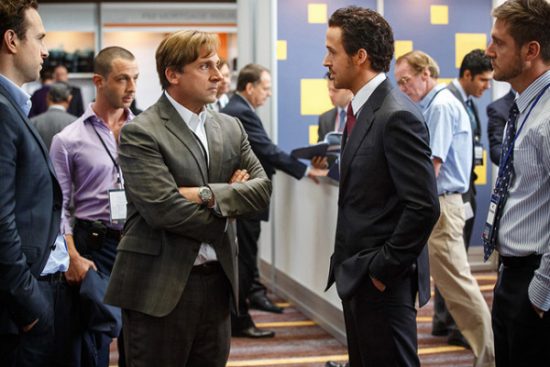Review: The Big Short
In Jurassic World there’s an in-joke about teaching people anything being kinda hard. The best way to educate isn’t to communicate just through logic and explanation, it’s to spice it up. Disguise it. Dress it up. So when the rides at Jurassic World try to teach the park patrons stuff about both the park and the dinosaurs inside it, it’s communicated through the warm, half-fake exploding laugh of Jimmy Fallon. As a cameo, it’s goofy, fun, and a bit clever. This is the entire approach to Adam McKay’s The Big Short, which dramatizes the implosion of mortgage market bubble that led to the huge worldwide economic crisis back in 2007 with every joke, gimmick, and cheap parlor trick it could conceive. It’s kind of the “fun” Margin Call. This movie is so passionate about winning you over through any half-assed, cheap way it can that it even gave Brad Pitt, Christian Bale, Steve Carell, and hunk of hunks Ryan Gosling the goofiest haircuts this side of 1970. The goal is to inform you in as fun a way as possible, making art seems to be another question. In the end, there is real merit in both categories.
This is the more savoury cousin to The Wolf of Wall street, a connection the filmmakers did not gloss over by way of meta-referencing an actress from that film. It’s also way, way, way less cinematic. This looks like a TV show, and I don’t mean in the Cary Fukunaga glamorized sense of True Detective’s famous and cinematic single take. In the same way documentaries sometimes re-enact actual events, a style popularized by the landmark doc The Thin Blue Line, The Big Short is a movie restaging a figurative documentary that to my knowledge doesn’t really exist. What seems like half the movie is a hyper-fun, jokey powerpoint presentation on the history of the housing market, Wall Street, economics, the forgettable terms that define all those things as well as the the complex relationships between them. The plot isn’t really a story, it’s mostly a dramatic amped up version of real life events, played by super hot, wired guys spitting out dialogue like they walked on the set of an Aaron Sorkin movie.
The characters becomes cyphers for ideas bigger than any one person. You’ve got the two startup guys (John Magaro, Finn Wittrock) full of hope, idealism, and an edge for making good deals. But their journey to Manhattan shows that even turning $100,000 in investments into $30 million isn’t worthy of a seat at the big table. Bummer. Pitt has to step in to help, representing how even the most weathered, cynical money guys can be bought back into fold. Steve Carell’s hothead becomes a springboard for the movie’s moral centre, to give a human, flawed framework for what these big bankers were doing so wrong. Ryan Gosling’s slimy corporate big shot is the closest the movie has to a Jordan Belfort, a wild, money-obsessed guy whose only interest is of the kind that starts with “self.” Most memorable is Christian Bale, not only for his typically terrific performance which has so many nuances it inevitably becomes a loud Oscar-y turn, but his eccentric character Michael Burry seems to fetishize numbers and markets in the exact same way the movie hopes to for the audience.
What at first seem like in your face ploys to get you on The Big Short’s ride to inform while entertaining (hell, hiring the guy who did Step Brothers probably helped sell this movie to its own investors, ironically) do slowly transition from effective chuckle generators to having a deeper purpose. Hank Corwin’s trigger happy editing jumps around so fast we might lose track of vital info—honestly, I did—but as the film’s third act hits at the arrival of the 2007 financial crisis, the same impressionistic touch to the characters becomes a dominant aesthetic choice. Cuts start to interrupt sentences and conversations to the point it’s like two totally different conversations in two totally different places start to complete each other. We carousel through our main characters and their respective missions, arcs, and symbolic design to paint as vivid, visceral, and memorable a portrait of this crisis and how it exploited, destroyed, and sucked up all of our money as possible, and it’s only by painting so broadly does this picture ever really come into view. The Big Short is self-evidently powerful, but to make it such a hyper-attractive package is about the best way possible to give us the information and the message. The most entertaining economics lesson of 2015.











